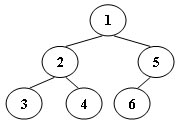An inorder binary tree traversal can be implemented in a non-recursive way with a stack. For example, suppose that when a 6-node binary tree (with the keys numbered from 1 to 6) is traversed, the stack operations are: push(1); push(2); push(3); pop(); pop(); push(4); pop(); pop(); push(5); push(6); pop(); pop(). Then a unique binary tree (shown in Figure 1) can be generated from this sequence of operations. Your task is to give the postorder traversal sequence of this tree.

Figure 1
Input Specification:
Each input file contains one test case. For each case, the first line contains a positive integer N (<=30) which is the total number of nodes in a tree (and hence the nodes are numbered from 1 to N). Then 2N lines follow, each describes a stack operation in the format: "Push X" where X is the index of the node being pushed onto the stack; or "Pop" meaning to pop one node from the stack.
Output Specification:
For each test case, print the postorder traversal sequence of the corresponding tree in one line. A solution is guaranteed to exist. All the numbers must be separated by exactly one space, and there must be no extra space at the end of the line.
Sample Input:
6 Push 1 Push 2 Push 3 Pop Pop Push 4 Pop Pop Push 5 Push 6 Pop PopSample Output:
3 4 2 6 5 1题目实质是通过先序遍历和中序遍历建树,再后序遍历树。
解题思路
1. 通过输入建树
Push操作代表新建一个节点,将其与父节点连接并同时压栈
Pop操作,从栈顶弹出一个节点
2. 后序遍历:递归实现
代码如下:
#include <cstdio>
#include <cstring>
#include <cstdlib>
#define STR_LEN 5
#define MAX_SIZE 30
typedef struct Node
{
int data;
struct Node *left, *right;
}* treeNode;
treeNode Stack[MAX_SIZE];
int values[MAX_SIZE];
int num = 0;
int top = -1;
void Push(treeNode tn);
treeNode Pop();
treeNode Top();
bool isEmpty();
void PostOrderTraversal(treeNode root);
int main()
{
int n;
char operation[STR_LEN];
treeNode father, root;
bool findRoot = 0, Poped = 0;
scanf("%d", &n);
for (int i = 0; i < 2 * n; i++)
{
scanf("%s", operation);
if (strcmp(operation, "Push") == 0)
{
int value;
scanf("%d", &value);
treeNode newNode;
newNode = (treeNode)malloc(sizeof(struct Node));
newNode->data = value;
newNode->left = NULL;
newNode->right = NULL;
if (!findRoot)
{
root = newNode; //根节点
Push(newNode);
findRoot = 1;
}
else
{
if (!Poped) //如果前一个操作不是pop,则父节点为栈顶元素
father = Top();
if (father->left == NULL)
father->left = newNode;
else
father->right = newNode;
//printf("%d\n", newNode->data);
Push(newNode);
}
Poped = 0;
}
else
{
father = Pop();
Poped = 1;
}
}
PostOrderTraversal(root);
for (int i = 0; i < num-1; i++)
printf("%d ", values[i]);
printf("%d\n", values[num-1]);
return 0;
}

